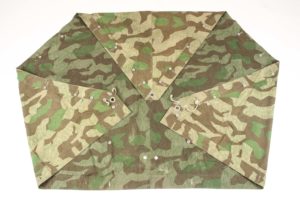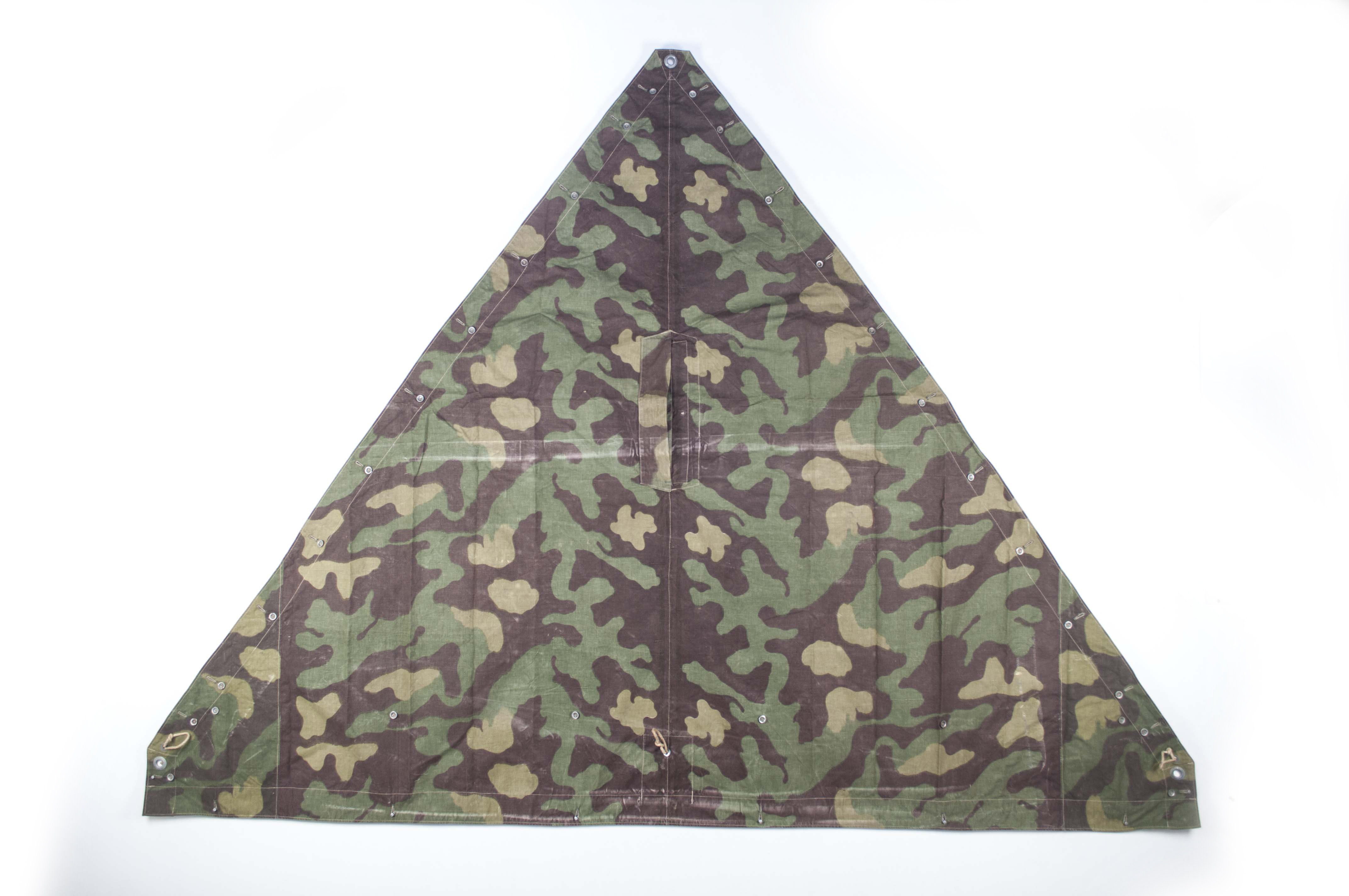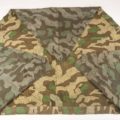Zeltbahn 31 – Splittertarnmuster – Luftwaffe marked
The Zeltbahn 31 was the issue shelter quarter of the German army. It was patterned on 3.9.1926 by Walter Reichert. The zeltbahn is a triangular piece of camouflaged cloth usable as a rain poncho or as a shelter. The material used in the construction is so called Makostoff with a roller or screen printed camouflage pattern on it. Throughout the war the Zeltbahn 31 went through a bunch of simplifications but the basic design remained basicly unchanged.
The Zeltbahn is featured with a set of 62 buttons to close it or combine it with others to form a tent. These buttons where initially made of aluminium but later where executed in zinc, steel or bakelite(Italian capture). The Zeltbahn is featured with 9 grommets; one big grommet at every corner to feature the tent pole, three sets of 2 small grommets on the bottom which held 3 28cm sections of rope. These ropes are used to stake down the Zeltbahn when it is used as a tent. Later in the war the number of grommets used was brought down to 6 to save raw materials.
Initially it was executed in a field gray fabric but in 1930 the Reichswehr copied the Italian idea of printing camouflage on the Zeltbahn. The Reichswehr then designed the Buntfarbenaufdruck camouflage pattern which was later renamed to Heeres-Splittermuster 31 (Splittertarnmuster). It was printed on the used by all arms in the Reichswehr and later Wehrmacht. In 1935 the SS-VT first started experimenting with other camouflage patterns. In 1936 the first Zeltbahnen in SS camouflage where fielded and tested. By the end of the war the SS had designed and fielded many different camouflage patterns.
After the capitulation of the Italian army in 1943 their camouflage printing rollers and uniform/equipment stocks where captured and brought back to Germany. It was then that the first Zeltbahnen of captured Italian camouflage material (Telo Mimetico) where produced. Also some experiments where done combining Telo Mimetico with Splittertarnmuster. This is known to collectors as carbon overprint and consists of a base of the brown base colour Telo Mimetico printed in carbon ink overprinted with Splittertarnmuster. This is a rare variation initially intended to camouflage against infrared light.
Four Zeltbahnen buttoned together made up a small pyramidal tent which served as a shelter for four soldiers. Next to 4 zeltbahnen 4 poles and 8 stakes where needed. It was nearly endlessly combinable by adding more Zeltbahnen constructing bigger tents. In theory every Zeltbahn was issued with the following equipment;
– 1 Zeltleine 92 (tent rope), a 2 meter long, 4 mm thick cord with two loops on each end. Usually in Dark blue or natural colour.
– 1 Zeltstock 01 (tent pole), a 38 cm long pole with blued steel fittings.
– 2 Zeltpflöcke 29 (tent stakes), Aluminium, steel or bakelite tent stakes with a small piece of 4mm cord at the end.
These where meant to be carried in the Zeltzubehörtasche (tent accessory bag) but they where usually kept wrapped in the rolled up zeltbahn.
Camouflage Pattern: Splittertarnmuster
Year: 1938
Button/grommet material: Zinc
Notes: 1936 dated Zeltbahn marked Boelcke, and Fl. H. K. (Fliegerhorstkommandatur Würzburg). Kampfgeschwader 27 „Boelcke“ flew many missions in the early stages of the war bombing the Netherlands, Belgium, France and the United Kingdom. The zeltbahn is in good used condition but rare to find a Luftwaffe marked zeltbahn!











